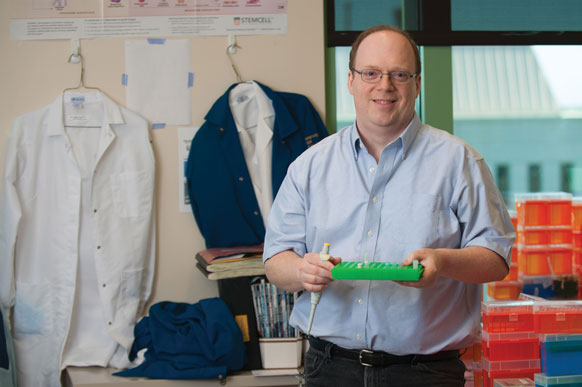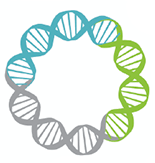
IRIS login | Reed College home Volume 95, No. 3: September 2016
Engineering the Human Race

Photo by Anne Williams
New technology gives us the power to manipulate the human genome. Should we use it?
By Shelly Skolfield ’14

A young couple sits in a lavish designer office, flipping through catalogues and hemming and hawing over the latest styles and features. She is a radiant young woman with exquisite cheekbones and flashing eyes. He is a tall, muscular fellow with wavy hair and a flawless smile. As they bicker over color choices, they could be picking out a living room set or a new minivan. But in fact they are shopping for the attributes they would like to give their firstborn child—a son or daughter who will join them in the ranks of a new race of designer humans.
This is not a scene from a science-fiction film. It’s a scene from our future, according to stem-cell researcher Paul Knoepfler ’89. His new book, GMO Sapiens: The Life-Changing Science of Designer Babies, explores the history of genetically modified organisms, our capacity to apply this technology to people, and the ethical questions surrounding both.
Knoepfler argues that the clock is ticking when it comes to preparing for genetically modified humans. He speculates that the first attempts could be made as soon as within the next five years, largely due to the success of a new gene editing tool known as CRISPR/Cas9 (often shortened to CRISPR and pronounced “crisper”) ,which he describes as a “genetic Swiss Army knife.”
The CRISPR system was created by cleverly hijacking a part of the immune system found in bacteria that evolved to identify and destroy genes belonging to viruses that attack these bacteria. This process has been understood for decades, but the real innovation came in 2012, when a team of researchers figured out a relatively quick and easy way to reprogram these bacterial molecules to pinpoint, delete, and even rewrite any gene in any living thing.

A CRISPR CUT: click above to see the details of the CRISPR system. Reprinted with permission of The Scientist. illustration originally appeared in article from march 1, 2014.
Combined with conventional in vitro fertilization techniques, CRISPR could allow doctors to edit the genes of a human embryo any way they wish. The potential implications are extraordinary: parents could eliminate devastating genetic diseases such as cystic fibrosis, sickle cell anemia, and Huntington’s disease. But why stop there? The same technology could allow parents to engineer a healthier child. For example, the child could be resistant to infections, developing cancer, and becoming obese. They could be “better” in a lot of ways: height, IQ, muscle tone, and endurance. It seems as the catalog of understood genes grows, the power to control their associated traits is becoming a reality. Perhaps Team Edward fans, nostalgic for the Twilight series, will one day give their children bioluminescence genes for that extra shimmer. (These are not theoretical chimeras—in 2013, researchers in Istanbul created glow-in-the-dark bunnies.)
Knoepfler knows what he’s talking about. An associate professor at the UC-Davis, he is on the front lines of cancer research. He is also devoted to public outreach. He wrote a book about stem cell research and maintains an influential blog devoted to the field. Despite receiving some pushback from other members of the scientific community, he believes it is urgent that the lay public discuss and debate the issues of how science, medicine, and society should intersect.
CRISPR is a case in point. Although the technology represents a substantial improvement in precision and power over previous genetic editing systems, it still makes mistakes. For instance, CRISPR may go to work at the wrong place in the genome. Even if it finds the gene it was designed to target, it may make the wrong correction. And, yes, you can put your hand down, Dr. Ian Malcolm, there is the fact that the genome is an incredibly complex and intertwined network that remains imperfectly understood. Even if CRISPR does exactly what it was designed to do, the potential for setting off unforeseen genetic consequences is substantial. And any mistakes would be inheritable, making the disaster a transgenerational one.
Knoepfler points out that the negative publicity after an accident could create a backlash that could set back any useful therapies by decades. He cites the tumultuous history of gene therapy, a genetic technique that has been used to treat children with X–linked severe combined immune deficiency (the so-called “bubble babies”). At first, the treatment seemed successful in clinical trials, restoring the immune function of children suffering from this life-threatening disease. But then five of the children later developed leukemia, and one of them died. While gene therapy has come a long way since then, the public remains understandably skeptical.
In addition to worrying about the consequences of failure, however, he worries about the consequences of success. What will happen to society when a select group of people—presumably privileged and affluent—can design their children to be smarter, healthier, faster, more athletic, and better looking? Will this lead to the dystopian nightmare of Aldous Huxley’s Brave New World?
Such literary preoccupations come naturally to Knoepfler, who majored in English at Reed and wrote his thesis on Dickens and Melville. One Reed professor he remembers as having particular influence on him was Prof. Lena Lencek [Russian 1977–], whom he saw as a role model for being an author who was “super smart but super creative.”
After Reed, he taught at a school for kids with learning differences for several years before obtaining a PhD in molecular pathology from UC-San Diego. From 2001 to 2006, he was a research fellow at Fred Hutchinson Cancer Research Center in Seattle, and he is now assistant professor in the department of cell biology and human anatomy at UC Davis School of Medicine and assistant investigator and member at the Institute for Pediatric Regenerative Medicine, Shriners Hospitals for Children, Northern California. His wife, Anca Anastasescu Knoepfler ’90, is a physician in the UC Davis Medical Group, and their daughter, Aliana Knoepfler ’17, is a psych major at Reed.
Knoepfler got a firsthand look at life on the other side of the microscope in 2009, when he was diagnosed with prostate cancer—an experience that shaped the roles he’s taken on as a patient advocate and educator. “I was definitely interested in blogging before diagnosis, surgery, and all, but after I’d gone through that I felt more emboldened to go ahead and pull the trigger and start blogging. It felt like a risk, really, professionally because turning back the clock to 2009, it wasn’t quite as accepted.”
His book has attracted praise from other researchers. “Paul Knoepfler manages to convey the excitement and potential of genetic engineering without sounding like Pollyanna, and compassionate concern over its misuse without sounding like Chicken Little—a highwire act that is all the more virtuosic for its seeming effortlessness,” writes medical historian Nathaniel Comfort. “The book takes us on an engaging roller-coaster ride through the new genetics, which could greatly impact many economic, policy, and personal decisions in the next few years,” writes CRISPR pioneer George Church.
But his most significant accomplishment may be to help us understand that these issues are not fundamentally questions of science but questions of ethics—and that the responsibility of facing them belongs to all of us.

LATEST COMMENTS
steve-jobs-1976 I knew Steve Jobs when he was on the second floor of Quincy. (Fall...
Utnapishtim - 2 weeks ago
Prof. Mason Drukman [political science 1964–70] This is gold, pure gold. God bless, Prof. Drukman.
puredog - 1 month ago
virginia-davis-1965 Such a good friend & compatriot in the day of Satyricon...
czarchasm - 4 months ago
John Peara Baba 1990 John died of a broken heart from losing his mom and then his...
kodachrome - 7 months ago
Carol Sawyer 1962 Who wrote this obit? I'm writing something about Carol Sawyer...
MsLaurie Pepper - 8 months ago
William W. Wissman MAT 1969 ...and THREE sisters. Sabra, the oldest, Mary, the middle, and...
riclf - 10 months ago